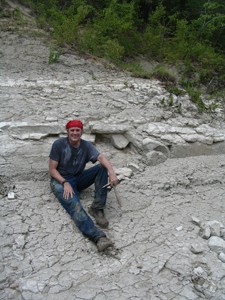
What Makes a Fossil?
Weve long been concerned with the quality of the fossil record, says Arnie Miller. The key to all this of course is the available fossil record. Miller points out that the most prominent issue is that the record gets larger and easier to sample the closer one gets to the present day in the Cenozoic Era. Therefore, weve long been concerned that global diversity curves, which show a big increase toward the present day, are biased.
The rock is less hard, Miller notes. For example, on the Virginia Coast in sediments that are only a few tens of millions of years old, you dont need a hammer, you need a sieve. Around Cincinnati, where the rocks preserve exquisite fossils that are more than 450 million years old, jackhammers and backhoes are sometimes helpful.
Miller also emphasizes the subtle difference between samples taken around the world versus literature published from around the world. That is, not every sample taken is subsequently described in the literature. So in examining fossils and analyzing them, there are several inherent challenges, some natural and some under human control:
Environmental
How preserved
Ecological
Nature of the rock itself
Duration of sampling
Number of samples
Number of articles published
The nature of communities changes over time how do you tally and correct for that? says Miller. And were trying to correct for all of them, basically.
Therefore, we have asked, Can we quantitatively correct for the differences in sampling from interval to interval? Miller says. Operationally, this involves some fairly arcane quantitative methods that, at heart, have a very simple goal: to quantitatively equalize the size of the paleontological sample from interval to interval throughout the geological record, so that we can build a new diversity curve that is free of the distortion that changes in sampling inevitably impart.
Related Stories
IMPACT Innovation at IDD Education center celebrates milestone
April 11, 2025
The IDD Education Center’s IMPACT Innovation program celebrates a major milestone as associate Haley secures a position at Adrian Durban Florist. Through hands-on training, mentorship, and community partnerships, IMPACT Innovation helps adults with autism develop independence, communication, and workplace skills. Haley’s mother shares how the program has supported her daughter's growth, while program director Genna Kieper highlights the role of job coaching in Haley’s success. Adrian Durban Florist, a long-time partner, continues to be a champion. The IDD Education Center remains committed to expanding employment opportunities for individuals with disabilities.
UC Journalism to host Hall of Fame, Young Alumni Awards
Event: April 24, 2025 6:00 PM
The College of Arts and Sciences’ journalism department will host the Hall of Fame and Young Alumni Awards to celebrate the achievements and accomplishments of its graduates. Induction into the UC Journalism Hall of Fame is a special honor reserved for UC alumni who have excelled in the profession of journalism and media, or individuals who have made a significant contribution to journalism at UC.
University launches UC Futures: Rural & Small-Town Scholars...
April 2, 2025
The University of Cincinnati has launched a new program to help introduce students in rural communities to the urban campus environment and support their next steps into higher education.
